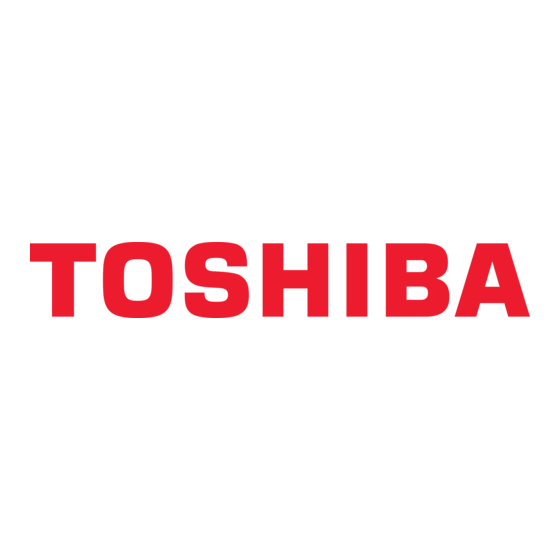
Table of Contents
Advertisement
Quick Links
Advertisement
Chapters
Table of Contents

Summarization of Contents
TOSHIBA Legal, Regulatory, and Safety
Copyright, Disclaimer and Trademarks
Outlines copyright, disclaimer, and trademark information.
Regulatory Information
Provides regulatory information applicable to the device.
FCC information
Details FCC compliance and notices for the device.
EU Declaration of Conformity
Explains CE mark compliance with European Directives.
Disposal of products
Instructions for proper disposal of the product.
Getting Started
Equipment checklist
Lists essential hardware and documentation items.
Conventions
Explains text formats used in the manual.
Using your computer for the first time
Basic steps to start using the computer.
Turning on the power
Steps for powering on the computer.
Getting to know Windows
Introduces basic Windows operations.
Turning off the power
Procedures for shutting down and restarting the computer.
Sleep Mode
How to put the computer into Sleep Mode.
Hibernation Mode
Description of the Hibernation Mode feature.
System Recovery
Overview of system recovery options.
The Grand Tour
Front with the display closed
Identifies components on the front of the computer when closed.
Left side
Identifies ports and components on the left side of the computer.
Right side
Identifies ports and components on the right side of the computer.
Back
Identifies components on the back of the computer.
Underside
Identifies components on the underside of the computer.
Front with the display open
Identifies components when the display is open.
Internal Hardware Components
Details the internal hardware components of the computer.
Power Condition Descriptions
Explains the computer's status indicators.
Operating Basics
Using the Touch Pad
Explains various touchpad gestures.
The Keyboard
Overview of the keyboard features.
Function Keys
Details the functions of the F1-F12 keys.
Optical disc drive
Information about the optical disc drive.
Battery
Information on battery types, use, and handling.
Wireless WAN Device
Information about the Wireless WAN device.
Memory media
Information about memory media slots and types.
Smart Card
Information about Smart Card usage.
External Display
Information on connecting external displays.
Sound System and Video mode
Describes audio control functions.
Utilities and Advanced Usage
Utilities and Applications
Describes pre-installed computer utilities.
TOSHIBA Password Utility
Utility for setting computer access passwords.
TOSHIBA System Settings
Utility for customizing hardware settings.
TOSHIBA eco Utility
Utility for managing power consumption and eco modes.
Special features
Describes unique or advanced computer features.
Sleep Mode
Allows turning off power without exiting software.
USB Charge
Computer supplies USB bus power to USB ports.
Using the Hard Disk Drive (HDD) Protection
Reduces risk of HDD damage using acceleration sensor.
Troubleshooting
Problem-solving process
Guidelines for easier problem resolution.
If something goes wrong
Common problems and solutions.
Hardware and system checklist
Lists areas to check for hardware problems.
Overheating power down
Causes and solutions for overheating shutdowns.
AC power
Troubleshooting AC power issues.
Battery
Troubleshooting battery-related problems.
Keyboard
Troubleshooting keyboard problems.
Internal display panel
Troubleshooting display panel issues.
Internal Storage
Troubleshooting internal storage issues.
Sound system
Troubleshooting sound system issues.
External monitor
Troubleshooting external monitor issues.
TOSHIBA support
Information on obtaining technical assistance.
Appendix
Specifications
Summarizes the technical specifications of the computer.
Environmental Requirements
Specifies operating and non-operating environmental conditions.
Power Requirements
Lists the power requirements for the computer and adaptor.
Information for Wireless Devices
Explains Wireless LAN and Bluetooth interoperability.
USA-Federal Communications Commission (FCC)
Compliance with US FCC rules for digital devices.
Information about Intel® AMT
Information on Intel Active Management Technology.
Memory (Main System)
Explains how system memory is used.
Glossary
Covers topics related to the manual.









Need help?
Do you have a question about the TECRA A50-D and is the answer not in the manual?
Questions and answers